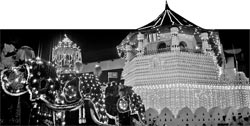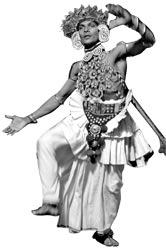
Our sacred heritageThe great chronicle Mahawamsa records that King Kirthi Sri Meghawanna also known as Kithsiri Mewan, during his reign in Anuradhapura was informed by the Mahavihara bhikkhus that Prince Danta and Princess Hemamala had arrived at Meghagiri (Isurumuni) bringing with them the Sacred Tooth Relic of the Buddha. The King went to meet them and ordered that a special casket be made to place the Sacred Relic. Placing the Relic in this ornate casket it was taken to Anuradhapura in a perahera (pageant). The Relic was placed at the Dhammachakka building which was later known as ‘Dhatughara’ which had been constructed by King Devanampiyatissa. King Kithsiri Mevan paid homage to the Sacred Relic and these rituals were continued by Kings Jetta Tissa, Buddhaghosa, Upatissa, Mahanama and King Mahinda V (Mihindu) who safeguarded the Relic. This was the first Dalada Perahera ritual which is still followed as the Esala Perahera in July/August in Kandy, the last stronghold of the Kandyan kings.
Fa Hien, the Chinese traveller who visited Anuradhapura in the 6th Century, in his writings has described the ceremony of the Sacred Tooth Relic which was conducted with great splendour. When Kandy was ceded to the British, the Kandyan Convention guaranteed the preservation of the Buddhist rituals and the Dalada Perahera. It’s the month of August and the Esala trees are in bloom with the yellow Esala blossoms cascading down their branches, reminding one of the annual Esala Perahera. Kandy is ready for this year’s perahera which begins today, August 19. The ‘Kap Situweema’ – (placing of a stump of a branch from a particular type of tree which has a milky sap) in the ‘Hatara’ (four) Devales was done on August 13 at 6.00 a.m. The first five peraheras from the 19th are the Kumbal which will continue until August 23. The grand Randoli Perahera will start on the 24th and end on the 28th with the Daval Perahera (Day Perahera) on the 29th after the ‘Diyakepeema’ (water slashing) ceremony at Getambe. Today, the Devala perahera, at the auspicious time of 7.10 p.m. facing East will leave the respective devalas and as customary, arrive at the Sri Dalada Maligawa. Thereafter, at 7.35 p.m. facing East, with the Maligawa perahera in the lead, it will wind its way along a few streets of Kandy. The preparations Wijewickremage Buddhika Tharanga Chandrasena, the cultural officer in charge of the Sri Dalada Maligawa (Temple of the Tooth Relic) Perahera ‘Angshaya’ (Department) was busy making preparations for the grand event when The Sunday Times met him this week. They have arranged for 18 tuskers to parade at this pageant. “Nedungamuwe Raja, the ‘lokuma etha’ (the largest) and ‘dala digama etha’, (tusker with the longest tusks) owned by Mr. Millangoda will take part in the pageant after an absence of many years,” he says. A rehearsal was held to select the best dancers and drummers. New costumes have been made. ‘Eth Hetta’ (cloth draped over the elephants) have been donated by a few well-wishers.” The Diyawadana Nilame spoke to the Prime Minister of Myanmar and requested for two tuskers. Accordingly they have received two tuskers aged 20 years and 27 years named Kaimantho and Moithaka. A veterinary surgeon, two mahouts and another have accompanied these elephants and are training the elephants to get acclimatized to Sri Lanka. “They are still not used to the local elephant talk,” Mr. Chandrasena adds. Doing the kariya A very important person during the perahera but one hardly spoken of is the Kariya Karawana Korale, often referred to as Kariya Korale who plays a prominent role during the perahera season. The present incumbent is the white bearded K. M. Karunatillake who says he came to the Maligawa in 1975 but was appointed to this post in 1985. The appointment is a form of ‘Rajakariya’ (family duty) and the position passes from father to son. The present Kariya Korale’s son Chaminda Karunatillake is already an understudy to this post and is present in the Maligawa.
During the Esala Perahera, an important duty of the Kariya Korale is to help the Diyawadana Nilame place the Perahera Karanduwa on the tusker. It is done at an auspicious time. The Kariya Korale stated that the ‘Karanduwa’ is taken out from the upper chamber of the Maligawa by the ‘Tewava’ (duty) Bhikkshu about ten minutes before the ‘nekath’ (auspicious) time when it has to be kept on the Maligawa tusker and handed over to the Diyawadana Nilame, only if he is in the ‘Mul Andum’ (traditional Kandyan costume). If he is not so attired, the Bhikkshu himself takes the ‘Karandua’ to be placed on the tusker at the ‘nekath’ time with the help of the Kariya Korale. The boom of a cannon heralds the arrival of the perahera to the waiting crowd. People crane their necks in anticipation. Suddenly the night sky glows with the reflection of the light from the torch bearers. The whip crackers walk in front shattering the silence of the night with the sharp sounds of the whips. Flag bearers follow carrying the Provincial and Buddhist flags. The ‘Peramunerala’ rides the first elephant with a scroll of the list of lands belonging to the Maligawa. Drummers follow. The next elephant carries the ‘Gajanayake Nilame’ with a ‘Henduwa’ (silver goad), who is in charge of the elephants. Colourful caparisoned elephants, dancers and more drummers follow. The drummers play the ‘Udekki’, ‘Daul’, ‘Tammattama’, and balance and rotate the ‘Rabana’ on a long stick. Dancers display their skill in traditional Kandyan dance performances – the ‘Ves’, Pantheru, Leekeli and other folk dances. Over the years, this pageant has included many folk dances. The Kariya Karawana Korale who is in charge of the Maligawa ceremonies next to the Diyawadana Nilame, in his white ‘Tuppottiya’, the traditional costume walks in front of the Maligawa Tusker, the most awaited elephant. He carries the Perahera Karanduwa in the ‘Ransivige’ and steps majestically on the ‘pavada’ a narrow white cloth about two feet in width and a few yards long which is very skilfully rolled-up once the tusker steps over and brought in front of the elephant once again to continue on its journey. The Diyawadana Nilame, one of the custodians of the Sacred Tooth Relic walks behind the Maligawa tusker. The ‘Ves’ dancers perform their dance. They wear a white and red trimmed costume with strings of beads woven across their chests (Aul heraya) and a conical head dress (Ves thattuwa). They keep step to a ‘Vannama’ a special kind of song and while dancing do a somersault. The Natha, Maha Vishnu, Kataragama and Pattini Devala Peraheras follow in that order. They too have their dancers, drummers, flag bearers etc. A tusker belonging to each Devale carries the insignia of the Deities. These elephants are decorated with fairy lights in the theme colours of the four Devales – gold for Natha, blue for Vishnu, red for Katharagama and yellow for Pattini. The Basnayake Nilame of each Devale walks in front of the respective Devale. For each segment of the pageant there are torch bearers, dancers and drummers. These performers have a ‘rajakariya’ an official duty to perform in the perahera which has been continuing for generations. Sadly, now there aren’t very many traditional families who perform and the artistes have to be found on payment. At the tail end of the pageant the ‘Randoli’ which are palanquins belonging to the Devales are carried and people deposit coins tied in pieces of cloth and make vows for their future safety and prosperity. The spectators are awe struck and amazed at this magnificent spectacle and sorry when it is all over – until the next Esala season. |
|| Front
Page | News | Editorial | Columns | Sports | Plus | Financial
Times | International | Mirror | TV
Times | Funday
Times || |
| |
Copyright
2007 Wijeya
Newspapers Ltd.Colombo. Sri Lanka. |

